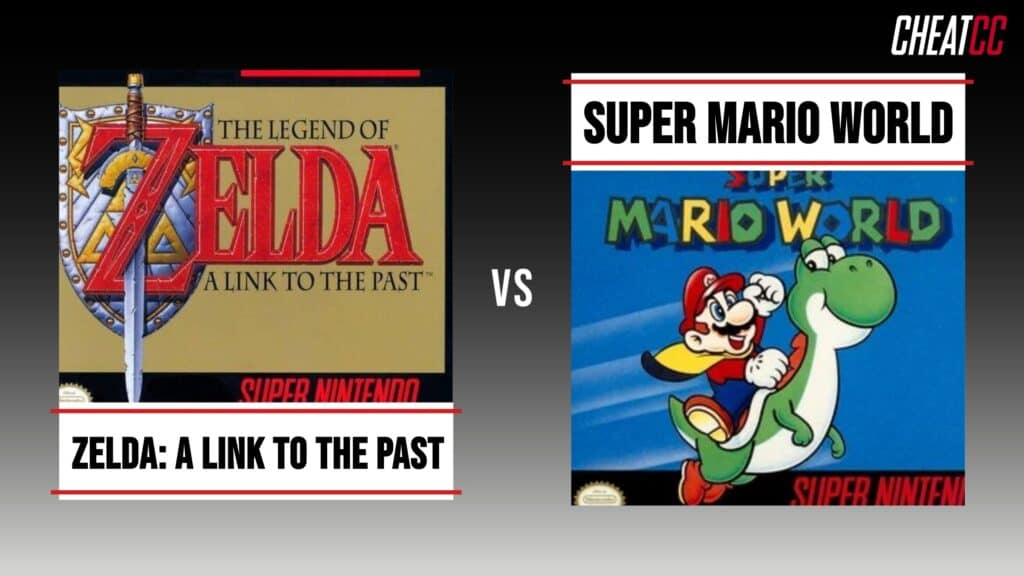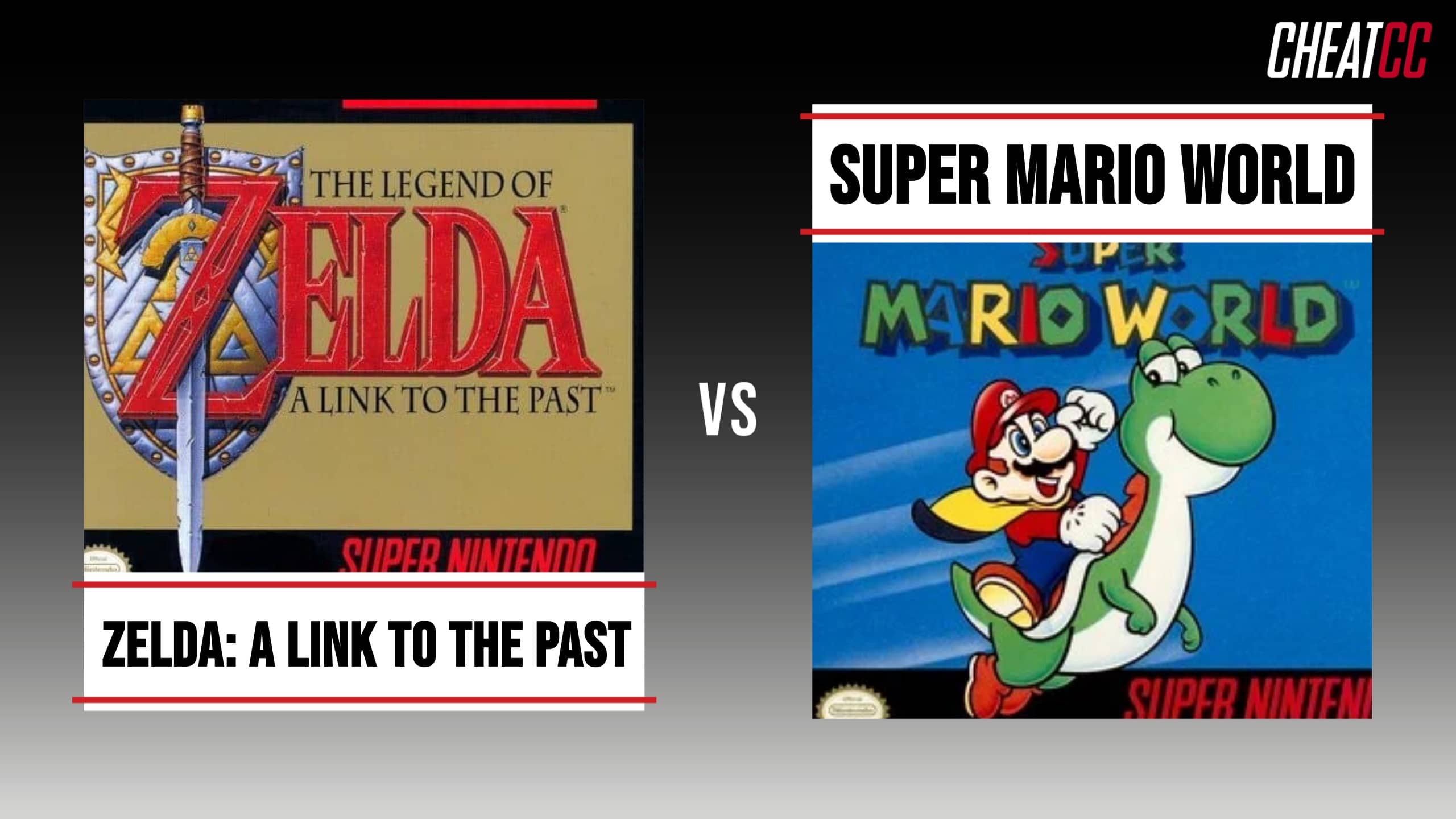Nintendo hardware continues to be defined by its incredible roster of first-party games, with the release of a new Zelda, Mario, or Metroid game amounting to a massive cultural event. The release of the SNES would prove to be uncharted territory for Nintendo, with most hardware manufacturers having been largely unsuccessful in releasing iterative consoles before the system’s launch. Thankfully, Nintendo’s decision to continue supporting the NES while making the SNES a must-have upgrade courtesy of its groundbreaking library helped usher in what we now know as the console generation cycle. And, of course, few games would be as important in moving Super Nintendo units as Nintendo’s first-party exclusives. Enter the battle between Zelda: A Link to the Past and Super Mario World.
Though not a launch title for the system, the arrival of a new Zelda game on the SNES would prove to be a major return to form for the series after the maligned Zelda II. Not only does it still stand as one of the best games in the series, it’s also one of the best action-adventure titles of all time and a contender for best SNES game. However, one could say the same about the SNES’ pack-in game — Super Mario World. By taking the foundation of Super Mario Bros. 3, slowing down the pace a bit and creating a greater emphasis on level exploration and secrets, Super Mario World set the foundation for pretty much every side-scrolling platformer (and future 2D Mario game) arriving after it. In terms of their importance to the SNES’ success and their overall impact on game design, both games are fairly evenly matched.
Zelda: A Link to the Past vs Super Mario World: Side-by-Side Comparison

Both Super Mario Bros. and The Legend of Zelda are integral titles in helping to make the NES successful in both its native Japan and the West, and their 16-bit follow-ups would end up doing the exact same for the SNES. Over its lifespan, the NES would sell just over 74 million units in both its native Japan and the West (a staggering number for the time). Not content to let its predecessor outperform it, though, the SNES would sell just over 84 million units worldwide and would do so in a shorter amount of time. It’s hard to imagine Nintendo’s 16-bit powerhouse being as successful as it is without the incredible first-party titles featured in the system’s library, of which A Link to the Past and Super Mario World are arguably the best.
| Characteristic | Zelda: A Link to the Past | Super Mario World |
|---|---|---|
| Release Date | November 21, 1991 (JP) April 13, 1992 (NA) | November 21, 1990 (JP) August 23, 1991 (NA) |
| Director | Takashi Tezuka | Takashi Tezuka |
| Producer | Shigeru Miyamoto | Shigeru Miyamoto |
| Composer | Koji Kondo | Koji Kondo |
| Review Aggregate Score | 93% | 94% |
| Total Sales | 4.6 million units | 20.6 million units |
| Place on SNES Best-Seller List | 7th | 1st |
| System Pack-In | ✅ | ✅ |
| Other Series Games Sharing Design | 6 | 5 |
| Available on Nintendo Switch Online | ✅ | ✅ |
Zelda: A Link to the Past vs Super Mario World: 5 Must-Know Facts
Here are 5 must-know facts when comparing A Link to the Past to Super Mario World for best SNES game:
- A Link to the Past and Super Mario World are both critical and commercial darlings for the SNES, each selling millions of copies and earning high critical praise. That said, Super Mario World outperforms A Link to the Past in both regards.
- The SNES would launch with Super Mario World as a system pack-in, though the console would feature several other games included in its SNES Control Set bundle throughout its lifespan. One of these titles would eventually be Zelda: A Link to the Past.
- Tellingly, both Zelda: A Link to the Past and Super Mario World feature the same core creative team and several of the same designers. Principal among these are the games’ director and producer, with both franchise’s creator Shigeru Miyamoto reprising his role as producer for both titles. Miyamoto’s guiding hand would oversee the production of both games for their series’ 16-bit debuts.
- Speaking of creative teams, both titles feature the music of legendary composer Koji Kondo. Kondo’s compositions and iconic sound design for both titles are hugely important factors in helping both A Link to the Past and Super Mario World earn their place as two bonafide classics.
- The impact of A Link to the Past and Super Mario World continues to be felt in both series’ 2D entries, with each franchise having several games that utilize their basic foundation as a design blueprint. Last year’s Super Mario Wonder is even somewhat of a spiritual successor to Super Mario World.
Zelda: A Link to the Past vs Super Mario World: Sales & Reception
Both Zelda: A Link to the Past and Super Mario World share strong critical and commercial reception. Interestingly, A Link to the Past and Super Mario World are fairly neck and neck in terms of their critical reception, with both titles having an impressive 93% and 94%, respectively. Further, A Link to the Past would be the first game to earn a near-perfect score in Japanese gaming publication Famitsu, scoring a 39/40. Regardless of the games’ comparable critical reception, though, Super Mario World absolutely trounces A Link to the Past‘s sales. Even though A Link to the Past would end up being the third-best selling game of 1992, its sales only total 4.6 million. Conversely, Super Mario World is the best-selling SNES game of all time, with a whopping near-21 million units in sales.
Zelda: A Link to the Past vs Super Mario World: System Pack-In
The release of the NES in the West would feature the original Super Mario Bros. as a system pack-in, securing the game’s place in millions of households across America and introducing an entire generation to Nintendo’s trademark plumber. Similarly, Nintendo’s strategy for the SNES’ launch in 1992 would have the console come as part of a bundle including Super Mario World. As the console’s life span wore on, Nintendo would continue to offer different first-party titles as pack-ins with the SNES Control Set, and The Legend of Zelda: A Link to the Past would be one of these titles roughly a year after its initial launch in the West. That said, thanks to Super Mario World‘s presence as a system launch title and pack-in, it’s no wonder that the game has such impressive sales figures and user adoption among SNES owners.
Zelda: A Link to the Past vs Super Mario World: Miyamoto’s Involvement
As the creator of both The Legend of Zelda and Super Mario Bros., it makes perfect sense that Nintendo luminary Shigeru Miyamoto would play a direct role in shaping each series’ 16-bit debut on his employer’s new hardware. Along with Miyamoto providing design guidance and serving as producer of each title, he would have Takashi Tezuka reprise his role as director for both games after previously working on both the original Super Mario Bros. and The Legend of Zelda, as well as directing the incredibly successful and groundbreaking Super Mario Bros. 3. Together, both Tezuka and Miyamoto would shape the qualities that came to define Nintendo’s first-party games on the SNES.
Zelda: A Link to the Past vs Super Mario World: Lasting Impact
Aside from both being incredibly important games to the SNES and its library, A Link to the Past and Super Mario World are two of the best games of all time and hugely influential within the context of their respective franchises. Every 2D game in both series arriving after their launch would use their design as a template moving forward, especially in the case of the Zelda franchise where every 2D game following A Link to the Past uses its overhead perspective, pacing, mechanics, and general elements. The original Super Mario Bros. would give way to a host of imitators following its incredible reinvention of the platformer genre, and Super Mario World would prove to do the same. There are several 2D side-scrolling platformers from the 4th console generation, and they all owe a debt of gratitude to Super Mario World.
Bottom Line
All of Nintendo’s first-party titles for the SNES now hold legendary status as both some of the best games of all time and the highlights of their respective franchises. Super Mario World, The Legend of Zelda: A Link to the Past, F-Zero, Pilotwings, Super Metroid; all of these titles are incredible games that could potentially earn their place on a “Best of” list, and they also all happen to share similar qualities that highlight the SNES’ unique capabilities as a system. Between its superior sound chip, expansive color palette, and 8 separate graphic modes (including the faux-3D Mode 7), Nintendo’s developers continually proved that they were some of the most talented at squeezing every bit of innovation out of the SNES. Perhaps no two games illustrate this more than A Link to the Past and Super Mario World.
Though A Link to the Past is one of the best-selling games on the SNES and a huge turning point for the design of subsequent 2D Zelda titles, it would fall far below the sales of Super Mario World. Regardless of whether one prefers Zelda to Mario, the fact remains that the SNES and its success in the West hinge entirely on the response to Super Mario World. Not only does Super Mario World perfect the Mario formula that Nintendo had been building toward with Super Mario Bros. 3 it also creates the rule book for other 2D platformers and is likely the first game that many SNES owners got to experience in 1991. For those reasons, Super Mario World is absolutely the definitive SNES game, as it’s impossible to imagine the console without it.
